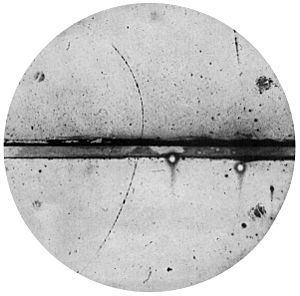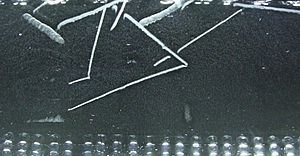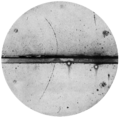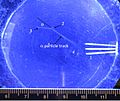Cloud chamber facts for kids

A cloud chamber is a sealed box with a supersaturated vapour of water or alcohol. When a charged particle (e.g. an alpha or beta particle) goes through it, the vapour is ionized. The resulting ions act as nuclei, around which a mist forms from the vapour.
The high energies of alpha and beta particles mean that a trail is left by ions produced along the path of the charged particle. These tracks have distinctive shapes (for example, an alpha particle's track is broad and shows more evidence of deflection by collisions, while an electron's is thinner and straight). When any uniform magnetic field is applied across the cloud chamber, positively and negatively charged particles will curve in opposite directions, according to the Lorentz force law.
The cloud chamber was invented by Charles Wilson (1869–1959), a Scottish physicist who received the Nobel Prize in Physics in 1927 for this work. The first cloud chamber was made in 1911. The invention was used in the early days of atomic physics. It is often called the 'Wilson chamber'. Since then a number of other types of particle detectors have been invented.
- Das Gupta N.N. & Ghosh S.K. 1946. A report on the Wilson cloud chamber and its applications in physics. Reviews of Modern Physics. 18, 225–365.
Images for kids
-
Fig. 1: Cloud chamber photograph used to prove the existence of the positron. Observed by C. Anderson.
-
Fig. 5: In a diffusion cloud chamber, a 5.3 MeV alpha-particle track from a Pb-210 pin source near Point (1) undergoes Rutherford scattering near Point (2), deflecting by angle theta of about 30 degrees. It scatters once again near Point (3), and finally comes to rest in the gas. The target nucleus in the chamber gas could have been a nitrogen, oxygen, carbon, or hydrogen nucleus. It received enough kinetic energy in the elastic collision to cause a short visible recoiling track near Point (2). (The scale is in centimeters.)
See also
 In Spanish: Cámara de niebla para niños
In Spanish: Cámara de niebla para niños







